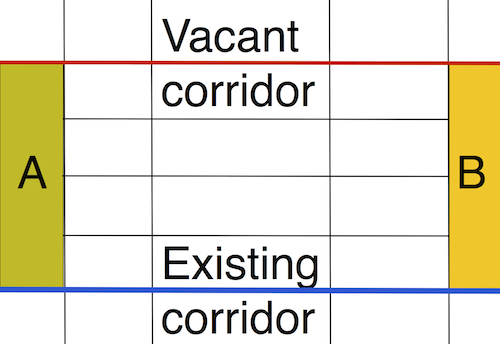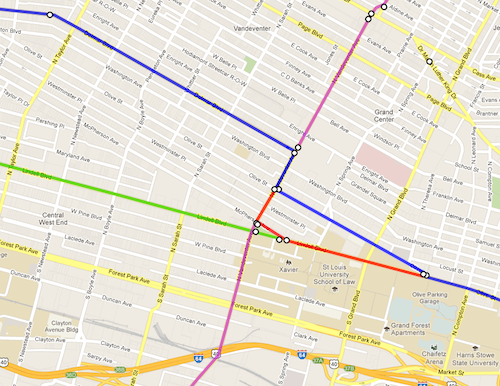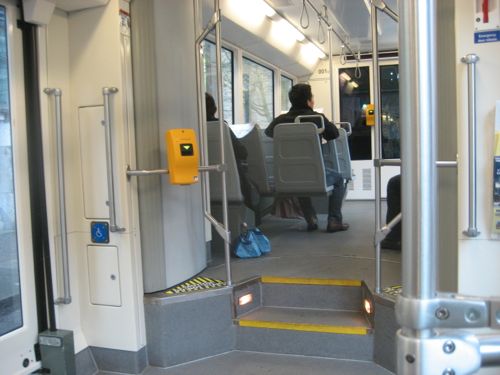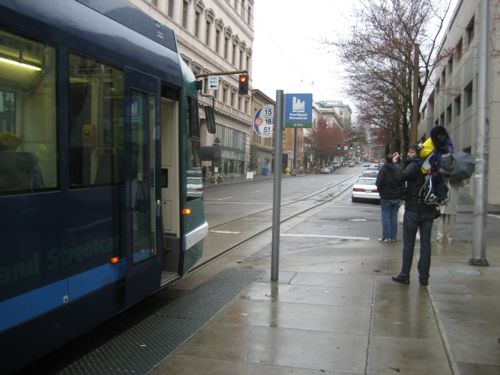Additional Thoughts On A Modern Streetcar In St. Louis
A couple of weeks ago I laid out a suggested route for a modern streetcar route from downtown to the Loop (Feasibility Of A Streetcar From Downtown To The Loop). I suggested using Olive, Vandeventer and Delmar. I’ve got more on the subject.
Extension of Loop Trolley, Not A New Start:
Alex Ihnen posted on NextSTL that Olive/Lindell was the “only feasible route” (see: Olive/Lindell Streetcar or Bust: Why a New St. Louis Line Must Build On Success) and that an all Olive route wasn’t a good option. I’m not sure who suggested a route on Olive West of Vandeventer,but I agree with Ihnen that staying on Olive isn’t wise but I disagree that Lindell is the only possibility.

Ihnen admits with his Lindell route the “problem remaining is the potential to connect to the Loop Trolley.” That’s a deal breaker of a problem! This streetcar line needs to be sold to the Feds as an extension of the Loop Trolley, not a new stand-alone system. Maintenance and storage buildings are costly so getting the maximum use of the Loop facility, rather than building a second, makes financial sense and increases the odds of getting the Feds to improve funding.
The Loop Trolley will initially use restored vintage cars, which are cheap to buy, but very costly to operate. Fortunately, the Loop Trolley is being designed to handle modern streetcars as well. Replacing the vintage cars with modern cars would come as part of an expansion. This is inevitable because the operating costs of the Loop Trolley won’t be sustainable.
So while we might talk about a downtown streetcar heading out west, the reality is the Loop Trolley would be extended east to downtown, something I’ve advocated since the Loop Trolley has been discussed. The most feasible way to get a streetcar line in midtown and downtown is building upon the Loop Trolley, not starting over from scratch.
Given that reality let me describe the route from the Loop to downtown. Extend the line east on Delmar from DeBaliviere to Vandeventer, south to Olive, east on Olive to the Central Business District.
The one alteration I’ve been thinking about is due to the fact the Olive/Lindell intersection was recently redone is to use McPherson for a block. When south on Vandeventer instead of turning east on olive the line could continue south two blocks then head east on McPherson in front of the Moolah Theater. These are diagramed later in this post.
Line Placement:
Conventional wisdom says run the streetcars through existing areas where people are now. Well, yes and no. One lesson we can learn from the 10+ years of the Portland streetcar is you want to do both. The line needs to serve busy points but by taking an under-developed path between those points you’ll see it fill up over time provided you’ve also put the right zoning in place.

If you’re at Euclid & Laclede you’ve got MetroLink a short walk to the south. Having a streetcar a short walk to the north at Euclid & Lindell would be great for the lucky few in between but the rest of the city should also benefit from such an investment in new infrastructure. Having the line run along Delmar on the north end of the Central West End it would serve residents on both sides of Delmar. It’d be a short walk from Left Bank Books at Euclid & McPherson to catch the streetcar at Delmar. Of course you can catch the #97 (Delmar) bus there now — every 30 minutes.

North-South Line:
On many sites people have said a north-south route is needed. I fully agree, an eastbound line from the Loop to downtown will give points to make connections to a future north-south route(s). Again, using the one maintenance facility saves considerable money and makes future lines more sellable to the Feds.
It’s my opinion that Vandeventer would serve as an excellent north-south route with excellent development potential. A streetcar line on Vandeventer would take pressure off the #70 Grand bus route. A north-south route further east such as Jefferson would also be good and would personally benefit me more, but I think Vandeventer is a better first north-south line. No the north it could stop at Natural Bridge, a good future east-west streetcar route as well as the preferred route for a light rail line to north county. Heading south on Vandeventer the line could turn south on Kingshighway.
Modern Streetcar vs Bus:
Some of you fail to see the difference between a modern streetcar and a bus, other than the obvious track and wire. The modern streetcar used in cities like Portland & Seattle is not like a railcar where you add on cars as need (Wikipedia). These have three sections, a middle and matching ends — no adding on. They are 66 feet in length, 6 foot longer than an articulated bus and 26 feet longer than a typical bus. Seating capacity is only 30 but standing capacity is an additional 127, most passengers stand since they’re going a short distance. Our 40 foot buses have a seating capacity of about 40 and standing isn’t feasible because you’re either in the way or you’ll fall over due to the bumpy ride. An articulated bus has a capacity of roughly 60+. For comparison our MetroLink light rail vehicles are 90 feet long and “a capacity of 72 seated and 106 standing passengers.” (Wikipedia)

Boarding a bus each passenger gets on one at a time, after others have gotten off the bus. It’s a slow process. With the modern streetcar riders pay their fare at the fireboxes on-board the streetcar.
The inflexible rail and wire are very important. These permanent items give developers the confidence to invest in high density development. The high density development supplies riders for the streetcar. Bus lines are incredibly efficient means from getting from point A to point B but a bus line, no matter how frequent, can’t generate the same level of development along a route. To help justify the capital expense of a streetcar the goodwill of developers along the length of the route cannot be left to chance. Government, in exchange for the investment in the infrastructure, should demand the density of development necessary to make it worthwhile. This last part is what wasn’t done 20 years ago around our MetroLink light rail stations.
Property owners with several blocks of a streetcar will benefit financially from the new transit infrastructure as their property value increases. Measures also need to be taken to ensure low-income persons aren’t priced out of high transit areas. This could be a freeze on property taxes for existing low-income homeowners to rent control for some rental units. The goal would be to add more middle and higher income residents without displacing those on the lower end.

Conclusion:
The bus is a fine mode for inner city public transit, it’s how I most often leave downtown. While it does it’s transit function well it doesn’t spur new development. The streetcar also does a great job at local transit but it’s strength is in development and creating new transit users. In making infrastructure decisions we cannot continue to put all our eggs into the CWE basket, we must spread it around.
– Steve Patterson
I disagree with the north south line which I believe should be on Broadway connecting the North Riverfront, downtown, Soulard, Benton Park, and south broadway. Zoning changes would have to be made in certain sections from industrial to residential and commercial but most of the infrastructure is in place but sits vacant.
I don’t think Vandeventer should be the only north-south route, just the first. Remember we must connect to the Loop Trolley and it’s maintenance facility.
Don’t be too focused on the current Loop Trolley maintenance facility. If the streetcar system is expanded as you and others envision, a larger facility will be required; the current one will be much too small.
I believe it’s being planned to handle a larger capacity, but it’d be easier to fund an expansion of the LT than to do a complete new system.
Boarding a bus each passenger gets on one at a time, after others have
gotten off the bus. It’s a slow process. With the modern streetcar
riders pay their fare at the fireboxes on-board the streetcar.
Modern buses are the same way. Tires vs. rails doesn’t affect how the fare is paid.
Absolutely agree with this. Biggest example is San Francisco MUNI which just approved all-door boarding on all of its bus lines.
We both know that’s hardly the same as boarding a streetcar. I love the bus but it has limitations.
I have no idea what you’re talking about. I suspect you’ve never taken the kind of bus I’m describing.
I’ve never paid bus fare at anything but a farebox when boarding. Besides St. Louis I’ve ridden local buses in NYC, Seattle, Bloomington-Normal. St. Louis uses very old fireboxes that will soon be replaced with smart card boxes. After those wear out in 30 years maybe Metro can try another type.
And I’ve ridden streetcars in Memphis and Tampa that use a single door and their bus system’s fareboxes. I’ve also ridden buses in Salt Lake City where you paid the farebox when you got off, and not when you boarded downtown, allowing all doors to be used for boarding in a busy area. Bottom line, either system can work on either vehicle type (bus or streetcar).
I’ve also ridden regional commuter buses in Denver that have only a single door, to maximize seating and passenger comfort on longer trips. I’ve been on rail systems, like ours, where proof of payment is used, and I’ve been on closed systems, like the El in Chicago, MARTA in Atlanta and the New York subways, where turnstiles limit access to paying customers.
Claiming that multiple doors and off-vehicle payment systems are exclusive to “modern” streetcars is simply not true – bus rapid transit typically uses the same types of solutions. What designers and system operators need to do is to provide the best combination for each unique operating environment.
The new policy starts on July 1. Pass readers have been installed at the rear door, cash & transfer riders must enter the front. This policy change was enacted because riders were boarding through the rear door due to the long lines and how slow the boarding process was. It remains to be seen if the new policy will get the bus to be on time or just manage to maintain the status quo. http://www.sfexaminer.com/local/transportation/2012/03/muni-begin-all-door-boarding-buses-july-1
Zoning changes would have to be made in certain sections from industrial
to residential and commercial but most of the infrastructure is in
place but sits vacant.
Or even better, build it in East St Louis! If you build it, they will come!
Broadway goes through mainly industrial, deserted neighborhoods outside of downtown, where it’s a largely dead, traffic choked one way street anyway. Oh, I see, you are downtown biased so of course you want the next street car line to go through downtown, regardless of the logic behind it.
While I agree with many of your observations and conclusions, I’m not sure how much I agree with your assumption that we should be using transit investments to “spur new development”, especially rail-based transit. Transit’s primary purpose is to move people, not to create winners and losers in the development community. If redevelopment happens, that’s a great side benefit, and should be supported by appropriate zoning changes and, potentially, tax incentives. But where to locate specific lines should not be defined by developers unless they’re willing to pay (and risk) the bulk of the investment dollars.
The most successful transit-related development initiative in Denver is the 16th Street Mall, which is focused on frequent, free BUS service connecting commuter rail and bus lines. The Pearl District in Portland developed at the same time as the Portland Streetcar. Streetcar advocates use it as their poster child, choosing to ignore the economic realities of both Portland’s urban growth boundary and the real estate bubble of the last decade, combined with Portland being viewed as a desirable place to live and to do business, combined to play a much bigger role.
Is a streetcar line (or a light rail line) an amenity that many people will appreciate? Something that could influence their choices in where to live or work? Yes, absolutely! The only real question is how to pay for it. Expecting the national or local governments to pay for investments like this, absent real ridership, is tough to do in today’s no-new-taxes environment. Creating local taxing districts, focused within several blocks of the actual corridor, makes more sense. The challenge with creating one here, however, using any of the alignments you’ve described, will be generating enough revenue without creating too much of a local tax burden. What are you, as a lower-income property owner, willing to pay in increased taxes? Or, are you expecting “someone else”, those potential “more middle and higher income residents” to bear the brunt of the costs?
Euclid through the heart of CWE could connect Delmar and Lindell.
And maybe if Lindell were actually treated like a streetcar corridor, then CVS wouldn’t be slated for the AAA site?
Grand baby, grand! It’s an old street car line and was made for this.
To paraphrase the old Bard…To dream, perchance to dream. You better find a better source of funding than ‘goverment’. That’s not going to fly today, tomorrow, or anytime soon. If we were the only City doing it, that would be one thing, but there are hundreds of cities out there fighting for a very, very limited amount of $$$. And let’s face it, Metro isn’t good at budgeting. But dream baby, dream!
Also, people totally ride buses while standing. A 40-foot bus has a standing capacity of around 20. The “bumpy ride” of bus travel does not appear to phase them.
I’m a bit skeptical of streetcar through areas to spur growth. Spurring growth was promised by Busch II and III, the dome, the arch, union station, etc. Seems to me we’ve gotten more return on wash ave and the loop. The loop trolley to me is a test run to show that it can work, and will make an already desireable area more desireable. By all means, Id love to see several lines going, but we need to crawl, walk then run rather than another magic bullet that may or may not pay off. For north/south, I vote grand. South grand would be better for it, and high metro ridership on that route justifies it to me.
The missing link, locally, in your vehicle size discussion, is that Metro does not use 60′ articulated buses. Yes, a modern 66′ articulated streetcar is bigger than a 40′ or 44′ standard transit bus (duh!) and can carry more passengers. If capacity is an issue on any route (bus or streetcar), adding more frequent service and/or adding larger vehicles will provide more capacity. Changing from rubber tires to rails, alone, does not increase capacity, and adding rails and catenary wires does not guarantee increased demand. “Build it and they will come” may work in the “Field of Dreams”; with limited resources, public transit needs to focus on meeting current demands, as efficiently as possible.
Metro has the funds to order articulated buses for the #70 (Grand) line, they just haven’t ordered them yet. Metro uses Gillig buses but they don’t sell an articulated version.
Metro actually uses buses from a variety of manufacturers. The reason I’ve been told that implementing articulated buses has been delayed is a combination of making sure the individual bus stops along Grand are big/long enough to accommodate them and having to make modifications to the Brentwood maintenance facility to handle them.
Portland, Milwaukee, and every other streetcar system I’ve looked at planned meticulously to connect EXISTING employers with EXISTING neighborhoods that were reasonably likely to supply riders. In other words, they decided to build the streetcar based on where there was a transportation need, not where dreamers and schemers were entertaining fantasies of development. I generally love this blog, but I find this particularly entry to be really divorced from reality. You of all people should be condemning the Loop Trolley for what it is: a ridiculous boondoggle that uses public money to benefit one large business owner. There is no practical “extension” plan that could redeem this waste of funds.
If anyone in St. Louis were interested in transit oriented development, then we wouldn’t have Dierberg’s still turning its back on the Metrolink all these years after the building of the Shrewsbury line, and we wouldn’t have a spanking new car dealership being built next to Sunnen Station.
A look at what a transit system will look like in 10,20 or 30 years is really the starting point, although individual routes have some value, but if they are not interconnected with a robust transit system then it may not matter what streetcars can or cannot do.
In fact the major fault of the Loop streetcar line is that is does not offer future connections.
I would go with Grand and Lindell for initial streetcar lines, Vandeventer especially is low density, with random styles of business strips, and with surrounding neighborhoods that are low density and barely identify with Vandeventer until it becomes Southwest.
In any case it does not make sense to threaten the success of streetcars by forcing them to become agents of development rather than agents of people movement. Lindell with SLU, Wash U, Grand Arts Center, Forest Park and downtown should be a focus, especially with an already existing density along Lindell that could support streetcars.
The first order of business should be to establish the viability of streetcars. Random routes that may (or not) encourage development should come after the streetcar system is established.
Ultimately Grand and Lindell are more favorable sites because they also connect almost directly with light rail (and in the case of Lindell, a connection to the Loop).
In the end I see the selection of Vandenventer route as the first north-south (actually north-southwest) streetcar route as a sign of a failure of transit planning.
I agree that Grand and Lindell sound like the most realistic proposals for streetcar lines. I also agree with the idea that building a streetcar line means more than increased transit options, that residents and visitors will see the (relative) permanence of the streetcar infrastructure as a sign that St. Louis is growing, not dying. Just the sense of modernity that a streetcar would bring could prove invaluable to the city, in that it would attract new merchants and new residents.
Maybe I just lack sufficient knowledge of the city, but I don’t completely understand why some are suggesting Vandeventer instead of Grand (or even Kingshighway or Jefferson) as a starting north-south line. There’s probably no use talking about it now anyway, but Grand seems like it would have the dual benefit of serving many different neighborhoods (especially those on South Grand) and attracting development/tourism on North Grand. Vandeventer has the advantage of being central between Kingshighway and Grand, but would those neighborhoods west of Tower Grove Park (down where Vandeventer goes) benefit as much (as Tower Grove proper) from a streetcar?
Lindell/Olive is undeniably the best east-west choice. Lindell has a long list of things going for it: there are already many residential buildings with high property values; it’s a nice straight boulevard; and it connects WashU, Forest Park, SLU, and downtown. Plus many famous St. Louis landmarks are on or close to Lindell. If we want a streetcar that we can show to the rest of the world, we need to put it on Lindell.
And for an example on why investing in a highly-subsidized bus may make more sense, check out http://www.news-journalonline.com/news/local/east-volusia/2012/06/24/daytona-beachside-dowtown-trolley-set-to-roll-monday.html
Is the real goal (of investing in transit) to spur development or to get more people to ride transit? Yes, they’re interrelated, but which goal is (decided to be) more important will inform how dollars are spent. The best ways to get people to ride transit are to make it free / substantially cheaper than driving (your motivator) and to make it more frequent.
Adding a new streetcar line will certainly alter the development dynamics for available sites adjacent to the line. But to assert that a streetcar line is or will be important is contradicted by the vast amount of successful development that is happening absent any public transit, much less rail-based transit.
More real numbers, from a Washington Post article: “If the District succeeds in rolling out a 22-mile network of streetcars in the next seven years, the ka-ching of the farebox may mean profits for private investors. The city is trying to entice private companies to construct and operate the planned system . . . . Ronaldo “Nick” Nicholson, chief engineer for the District Department of Transportation, . . . . said the system would cost about $1.2 billion to build and equip with 50 streetcars, and about $65 million a year to operate.”
Yes, it’s an apples and oranges comparison, but it’s also easy to do the math:
Average construction cost, per vehicle: $2.4 million
Avg annual operating cost, per vehicle: $1.3 million
Average construction cost, per mile: $5.4 million
Avg annual operating cost, per mile: $2.95 million
Compare that to Metro’s current $307 million budget, for both operating and capital expenses, and it’s easy to see why funding will remain the biggest hurdle.
http://www.washingtonpost.com/local/trafficandcommuting/private-sector-may-land-role-in-dc-streetcar-project/2012/06/27/gJQAQa1Z7V_story.html
I have seen the future and it’s not pretty. Tampa’s trolley is not too dissimilar from the Loop project, it’s been around for 10 years and continues to struggle. Getting it built is one thing, keeping it running is a whole ‘nuther: http://www.tampabay.com/news/business/tourism/mayor-buckhorn-vows-to-save-tampas-struggling-streetcars/1252236
That’s a very important piece of news. One of the most idiotic arguments in favor of the Loop Trolley is that it will attract tourists because it’s a) a novelty and b) just like what so many other cities have done successfully . The trolley can’t be both. Obviously tourists get bored with these things quickly, and there’s nothing particularly novel about the “clang-clang” of streetcars now that Memphis, Schmemphis, and Kenosha, Wisconsin all have the same thing. The Tampa streetcar actually goes someplace – a lot of places – and yet they can’t keep ridership the numbers that people once-upon-a-time considered a sure thing. We’re all going to be paying for this albatross.
Interesting / different perspective from across the state – provide “free” service on the new streetcar route to grow ridership, instead of expecting fares to cover a significant portion of the operating costs: http://www.bizjournals.com/kansascity/news/2012/09/26/kansas-city-streetcar-rides-will-be-free.html